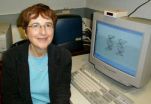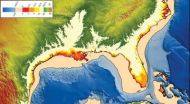(Press-News.org) A person doesn't have to go far to find a polycyclic aromatic hydrocarbon (PAH). These carcinogen precursors are inhaled through automobiles exhaust during the morning commute, are present in a drag of cigarette smoke, and are part of any barbequed meal.
Once ingested or inhaled, these big, bulky multi-ringed molecules are converted into reactive carcinogenic compounds that can bind to DNA, sometimes literally bending the double helix out of its normal shape, to form areas of damage called lesions. The damaged DNA can create errors in the genetic code during replication, which may cause cancer-initiating mutations.
It is the job of the nuclear excision repair (NER) system to repair damage caused by PAH lesions by removing the segment of DNA where the lesion is bound and patching up the resulting gap. But some lesions are especially resistant to this repair machinery, making them much more likely to cause mutations than lesions that are promptly repaired.
A research team at New York University (NYU) has gained new insight on the ability of certain PAH-derived lesions to evade the DNA repair machinery. They found that some lesions stabilize the DNA they damage, making it difficult for a certain repair protein to mark the lesion for repair. Their research was published earlier this year in the February 2012 issue of Biochemistry. More recent articles about NER of DNA lesions from the same group appeared in Nucleic Acids Research in July and August.
"Some lesions cause DNA to be locally destabilized, but there are lesions that actually stabilize the DNA so that the two strands come apart with great difficulty," said Suse Broyde, a biology professor at NYU. "Sometimes they're even more stable than undamaged DNA."
The stability of the DNA double helix is a key feature that determines whether DNA is flagged for repair in the first place by a protein called XPC. The protein patrols the genome looking for weakened areas. When it finds one, it slips a structure called a beta-hairpin between the strands, marking the DNA for NER. But if a lesion makes DNA more stable, the strands become more difficult to separate and the beta hairpin can't signal for repair.
How can molecules as large and disruptive as a PAH stabilize DNA in the first place?
"If you remember from chemistry, every kind of molecule interacts with other molecules through so-called Van der Waals interactions," said Nicholas Geacintov, a chemistry professor at NYU. "The DNA and the carcinogen bound to it also have the same kind of interactions," he said, specifically referring to the PAH-derived lesions that intercalate, or wedge themselves, between DNA base pairs.
The role of Van der Waals forces, which Broyde calls "stacking interactions" for these systems, was made clear through a series of computer simulations performed, analyzed, interpreted and visualized by Yuqin Cai, a post-doctoral senior research scientist in Broyde's lab. "The computer simulations revealed the structural, energetic and dynamic properties of the DNA containing the PAH-derived lesions, " said Broyde, who specializes in providing a mechanistic understanding of complex biological processes using molecular dynamics simulations and other front-line computational approaches.
"You can make movies of the dynamic trajectory which allow you to see the real mobility of the entire system," Broyde said. "You can watch the DNA flexing and the backbone moving dynamically and the carcinogen moving in and out. It's not rigid — you can see its aliveness."
Broyde and her team's simulations revealed that of the six different lesions examined (three chemicals with two different geometric configurations each), those caused by dibenzo[a,l]pyrene, the most tumorigenic PAH investigated, were the most resistant to repair. The five-ringed structure of the carcinogen provided ample stacking opportunities, which stabilized the DNA much better than the four and three-ringed structures of the other PAHs that were examined.
Knowing which lesions are the most repair resistant could play an important role in preventative medicine, said Broyde, as individuals harboring them could be counseled to avoid further exposure, particularly in the case of smokers.
The atomic-level visualizations Broyde's lab simulated explained data gathered from experiments that are carried out in Geacintov's lab, including synthesis of the damaged DNA, measurements of its stability, and investigations of the relative NER susceptibility of lesion-containing DNA in human cells.
"Without experiments they wouldn't have anything to model and without modeling it would be very hard for us to understand what we are measuring," Geacintov said.
Some of the most important results came from DNA melting experiments, where a specific sequence of double-stranded DNA was synthesized with a known lesion and then heated up until the strands separated. The more stable the DNA, the higher the temperature at which it melted. The most stabilizing lesion melted nearly 10 degrees higher than the melting temperature of DNA with no lesions; this lesion was the most repair-resistant in experiments and also most stabilizing according to molecular simulations.
To compute the raw data (coordinates of structures as a function of time) for the analyses and visualizations, the Broyde lab used the Longhorn, Lonestar and Ranger high-performance computing resources at the Texas Advanced Computing Center as well as other systems in the Extreme Science and Engineering Discovery Environment (XSEDE).
Uncovering the stabilizing properties that allow some lesions to evade NER and initiate cancer could help develop better chemotherapeutic drugs to fight the disease, according to Broyde and Geacintov.
For example, the widely used chemotherapy drug, Cisplatin, attacks the DNA of cancerous cells, interrupting unregulated replication. However, the cell's own NER machinery can combat the drug by removing it and repairing the genome, just as in healthy non-cancerous cells.
"One direction in drug design is to find pharmaceuticals that still inhibit replication but that are less susceptible to NER," Broyde said. "Understanding the mechanism of NER will be valuable in designing the next generation of chemotherapeutic agents. These would be more effective if they were more resistant to NER."
INFORMATION:
Cancer bound
NYU researchers use simulations on TACC, XSEDE supercomputers to understand how some carcinogens evade removal by stabilizing the very DNA they attack
2012-11-02
ELSE PRESS RELEASES FROM THIS DATE:
Navy researchers look to rotating detonation engines to power the future
2012-11-02
WASHINGTON--With its strong dependence on gas-turbine engines for propulsion, the U.S. Navy is always looking for ways to improve the fuel consumption of these engines. At the Naval Research Laboratory (NRL), scientists are studying the complex physics of Rotating Detonation Engines (RDEs) which offer the potential for high dollar savings by way of reduced fuel consumption in gas-turbine engines, explains Dr. Kazhikathra Kailasanath, who heads NRL's Laboratories for Computational Physics and Fluid Dynamics.
Many Navy aircraft use gas-turbine engines for propulsion, with ...
Solar system's birth record revised
2012-11-02
Some 4.567 billion years ago, our solar system's planets spawned from an expansive disc of gas and dust rotating around the sun. While similar processes are witnessed in younger solar systems throughout the Milky Way, the formative stages of our own solar system were believed to have taken twice as long to occur. Now, new research lead by the Centre for Star and Planet Formation at the Natural History Museum of Denmark, University of Copenhagen, suggests otherwise. Indeed, our solar system is not quite as special as once believed.
Using improved methods of analysis of ...
Disaster defense: Balancing costs and benefits
2012-11-02
Do costly seawalls provide a false sense of security in efforts to control nature? Would it be better to focus on far less expensive warning systems and improved evacuation procedures that can save many lives?
Seth Stein, a Northwestern University geologist, has teamed up with his father, Jerome Stein, an economist at Brown University, to develop new strategies to defend society against natural disasters like Hurricane Sandy as well as the effects of climate change.
The approach, which considers costs and benefits while looking for the best solution, is based on a ...
Were dinosaurs destined to be big? Testing Cope's rule
2012-11-02
Boulder, CO, USA – In the evolutionary long run, small critters tend to evolve into bigger beasts -- at least according to the idea attributed to paleontologist Edward Cope, now known as Cope's Rule. Using the latest advanced statistical modeling methods, a new test of this rule as it applies dinosaurs shows that Cope was right -- sometimes.
"For a long time, dinosaurs were thought to be the example of Cope's Rule," says Gene Hunt, curator in the Department of Paleobiology at the National Museum of Natural History (NMNH) in Washington, D.C. Other groups, particularly ...
Study: Alcohol, drug abuse counselors don't always require total abstinence
2012-11-02
WASHINGTON – Compared to a survey conducted nearly 20 years ago, about twice the proportion of addiction counselors now find it acceptable for at least some of their patients to have a drink occasionally – either as an intermediate goal or as their final treatment goal, according to a new study published by the American Psychological Association.
The researchers surveyed 913 members of the National Association of Alcoholism and Drug Addiction Counselors from across the United States. About 50 percent of the respondents said it would be acceptable if some of their clients ...
Difficult-to-read font reduces political polarity, study finds
2012-11-02
CHAMPAIGN, lll. — Liberals and conservatives who are polarized on certain politically charged subjects become more moderate when reading political arguments in a difficult-to-read font, researchers report in a new study. Likewise, people with induced bias for or against a defendant in a mock trial are less likely to act on that bias if they have to struggle to read the evidence against him.
The new research, reported in the Journal of Experimental Social Psychology, is one of two studies to show that subtle manipulations that affect how people take in information can ...
Abstract thinking can make you more politically moderate
2012-11-02
CHAMPAIGN, lll. — Partisans beware! Some of your most cherished political attitudes may be malleable! Researchers report that simply answering three "why" questions on an innocuous topic leads people to be more moderate in their views on an otherwise polarizing political issue.
The research, described in the journal Social Psychological and Personality Science, explored attitudes toward what some people refer to as the ground zero mosque, an Islamic community center and mosque built two blocks from the site of the former World Trade Center in New York City. When the Islamic ...
Researchers 'watch' antibiotics attack tuberculosis bacteria inside cells
2012-11-02
NEW YORK (Nov. 1, 2012) -- Weill Cornell Medical College researchers report that mass spectrometry, a tool currently used to detect and measure proteins and lipids, can also now allow biologists to "see" for the first time exactly how drugs work inside living cells to kill infectious microbes. As a result, scientists may be able to improve existing antibiotics and design new, smarter ones to fight deadly infections, such as tuberculosis. The new study was published in today's early online edition of Science.
"The development of antibiotics has been stalled for several ...
Why seas are rising ahead of predictions
2012-11-02
Boulder, CO, USA – Sea levels are rising faster than expected from global warming, and University of Colorado geologist Bill Hay has a good idea why. The last official IPCC report in 2007 projected a global sea level rise between 0.2 and 0.5 meters by the year 2100. But current sea-level rise measurements meet or exceed the high end of that range and suggest a rise of one meter or more by the end of the century.
"What's missing from the models used to forecast sea-level rise are critical feedbacks that speed everything up," says Hay. He will be presenting some of these ...
Bird tree tells new tale of evolution
2012-11-02
Contact:
Arne Mooers, 778.782.3979, amooers@sfu.ca
Carol Thorbes, PAMR, 778.782.3035, cthorbes@sfu.ca END ...
LAST 30 PRESS RELEASES:
Membrane magic: FAMU-FSU researchers repurpose fuel cells membranes for new applications
UN Member States pledge to increase access to diagnosis and inhaled medicines for the 480 million people living with COPD
Combination therapy shows potential to treat pediatric brain cancer ATRT
Study links seabird nesting to shark turf wars in Hawai‘i
Legal sports betting linked to sharp increases in violent crime, study finds
Breakthrough AI from NYUAD speeds up discovery of life-supporting microbes
New Eva Mayr-Stihl Foundation funding initiative boosts research at University of Freiburg on adaptation of forests to global change
The perfect plastic? Plant-based, fully saltwater degradable, zero microplastics
Bias in data may be blocking AI’s potential to combat antibiotic resistance
Article-level metrics would provide more recognition to most researchers than journal-level metrics
Satiety’s little helper: Protein that supports appetite regulating protein identified
UF dives deep into predicting storm damage with computer models
A stormy ocean voyage yields insights on the global carbon cycle
Scientists identify first non-coding gene that controls cell size
Demonstration of altermagnetism in RuO₂ thin films -- A new magnetic material for the AI era
Penn researchers awarded $25M to conduct trial using smartphones to fight heart disease
PCORI awards funding for new patient-centered healthcare research
Exploring the origins of the universe: 145 low-noise amplifiers complete ALMA telescopes
Empress cicada wings help illuminate molecular structure
Using sound waves to detect helium
Time burden in patients with metastatic breast and ovarian cancer from clinic and home demands
Researchers discover bias in AI models that analyze pathology samples
Scientists ID potential way to prevent brain injuries from triggering Alzheimer's
MASTER 2nd Open Call: Execution period kick-off
Algae for health in food and pharma
Advanced microrobots driven by acoustic and magnetic fields for biomedical applications
Chicago health information leader recognized for raising CPR readiness and blood pressure awareness
The Intimate Animal, a new book from Kinsey Institute Executive Director Dr. Justin Garcia
When blue-collar workers lose union protection, they try self-employment
New video dataset to advance AI for health care
[Press-News.org] Cancer boundNYU researchers use simulations on TACC, XSEDE supercomputers to understand how some carcinogens evade removal by stabilizing the very DNA they attack




